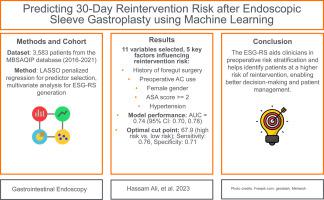Gastrointestinal Endoscopy ( IF 6.7 ) Pub Date : 2023-05-31 , DOI: 10.1016/j.gie.2023.05.059 Hassam Ali 1 , Pratik Patel 2 , Talia Farrukh Malik 3 , Rahul Pamarthy 1 , Babu P Mohan 4 , Ravishankar Asokkumar 5 , Gontrand Lopez-Nava 6 , Douglas G Adler 7

|
Background and Aims
Reintervention after endoscopic sleeve gastroplasty (ESG) can be indicated because of postprocedural adverse events from various preinterventional or postprocedural comorbidities. We developed and internally validated an ESG reintervention score (ESG-RS) that determines the individualized risk of reintervention within the first 30 days after ESG.
Methods
We used data from a sample of 3583 patients who underwent ESG in the Metabolic and Bariatric Surgery Accreditation Quality Improvement Program database (2016-2021). The least absolute shrinkage and selection operator (LASSO)-penalized regression was used to select the most promising predictors of reintervention after ESG within 30 days. The predictive variables extracted by LASSO regression were entered into multivariate analysis to generate an ESG-RS by using the coefficients of the statistically significant variables. The model performance was assessed using receiver-operator curves by 10-fold cross-validation.
Results
Eleven variables were selected by LASSO regression and used in the final multivariate analysis. The ESG-RS was inferred using 5 factors (history of previous foregut surgery, preoperative anticoagulation use, female gender, American Society of Anesthesiologists class ≥II, and hypertension) weighted by their regression coefficients in the multivariable logistic regression model. The area under the curve of the ESG-RS was .74 (95% confidence interval, .70-.78). For the ESG-RS, the optimal cutpoint was 67.9 (high risk vs low risk), with a sensitivity of .76 and specificity of .71.
Conclusions
The ESG-RS aids clinicians in preoperative risk stratification of patients undergoing ESG while clarifying factors contributing to a higher risk of reintervention.
中文翻译:

使用监督机器学习进行内窥镜袖状胃成形术再干预评分
背景和目标
由于各种干预前或术后合并症引起的术后不良事件,可能需要内镜袖状胃成形术(ESG)后进行再干预。我们开发并内部验证了 ESG 再干预评分 (ESG-RS),用于确定 ESG 后前 30 天内再干预的个体化风险。
方法
我们使用了代谢和减肥手术认证质量改进计划数据库(2016-2021)中接受 ESG 的 3583 名患者样本的数据。使用最小绝对收缩和选择算子 (LASSO) 惩罚回归来选择 ESG 后 30 天内最有希望的再干预预测因子。将 LASSO 回归提取的预测变量输入多变量分析,利用统计显着变量的系数生成 ESG-RS。模型性能通过 10 倍交叉验证使用受试者操作曲线进行评估。
结果
通过 LASSO 回归选择 11 个变量并用于最终的多变量分析。ESG-RS 是使用 5 个因素(既往前肠手术史、术前抗凝使用情况、女性、美国麻醉医师协会 ≥II 级和高血压)根据多变量逻辑回归模型中的回归系数进行加权推断的。ESG-RS 曲线下面积为 0.74(95% 置信区间,0.70-0.78)。对于 ESG-RS,最佳切点为 67.9(高风险与低风险),敏感性为 0.76,特异性为 0.71。
结论
ESG-RS 帮助临床医生对接受 ESG 的患者进行术前风险分层,同时阐明导致再次干预风险较高的因素。







































 京公网安备 11010802027423号
京公网安备 11010802027423号